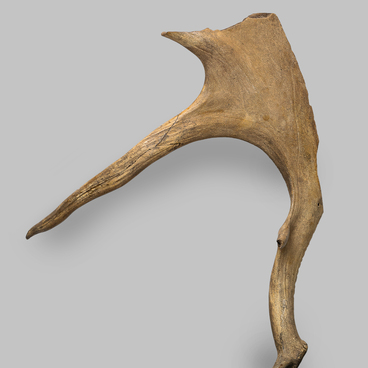Cupboards appeared in the Middle Ages but started to look similar to modern ones only in the 16th century. The first such cupboards with doors and shelves were made in France.
In the 17th century, corner cupboards appeared in France. Their shelves were used to store porcelain dishes and silverware. The cupboards could be single- and two-tiered, and their doors were equipped with various locks and latching mechanisms. Between the lower and the upper parts of the cupboard was a table and a spacious niche, which was used to store fruit bowls and bottles of wine in France, and souvenirs, decorative products, and beer mugs in Germany.
Baroque was the main style in Italy of the 16th — 17th centuries. Local furniture makers produced cupboards and embellished them with relief carvings and various decorative elements. The cupboards were most often painted with dark and bright oil paints and sometimes with light shades.
The Italian cupboard from the museum collection has a rectangular shape and two tiers. Two doors are attached to the front walls of the upper tier. They are decorated with a relief carving made of stained oak, depicting a biblical plot. The lower drawers are locked with a key, and the lock cylinders are shaped like lion heads. The sides are made of plywood and lined with narrow strips. The cupboard baseboards are relief, and the cornice ends with a massive carved pediment — several stepped strips with carved patterns. The massive cupboard stands on chiseled round legs.
In Russia, the production of cupboards started only in the 19th century. They differed in size and height, the ratio of the solid and glazed parts of the structure, as well as decoration, size, and finish of the cornices and legs. For dining rooms, the cupboards were often made low and wide. However, there were higher options, too. For example, display cabinets, that were called ‘gorka’ in Russian, which means a pile, because dishware pieces were usually arranged on top of one another.
Special attention was paid to the decoration of sideboards. The legs were a rare occurrence in the cupboards, for they were usually made floor-length and decorated with a heavy and massive sideboard. Solid doors were attached to the lower tier, the drawers were above them. The upper tier also had doors, solid or glazed.
In the 20th century, cupboards were mass-produced and therefore had no special decorations. Some kitchens were too small to fit a massive cupboard, so, as time passed, the cupboards were replaced with low and more compact sideboards.
In the 17th century, corner cupboards appeared in France. Their shelves were used to store porcelain dishes and silverware. The cupboards could be single- and two-tiered, and their doors were equipped with various locks and latching mechanisms. Between the lower and the upper parts of the cupboard was a table and a spacious niche, which was used to store fruit bowls and bottles of wine in France, and souvenirs, decorative products, and beer mugs in Germany.
Baroque was the main style in Italy of the 16th — 17th centuries. Local furniture makers produced cupboards and embellished them with relief carvings and various decorative elements. The cupboards were most often painted with dark and bright oil paints and sometimes with light shades.
The Italian cupboard from the museum collection has a rectangular shape and two tiers. Two doors are attached to the front walls of the upper tier. They are decorated with a relief carving made of stained oak, depicting a biblical plot. The lower drawers are locked with a key, and the lock cylinders are shaped like lion heads. The sides are made of plywood and lined with narrow strips. The cupboard baseboards are relief, and the cornice ends with a massive carved pediment — several stepped strips with carved patterns. The massive cupboard stands on chiseled round legs.
In Russia, the production of cupboards started only in the 19th century. They differed in size and height, the ratio of the solid and glazed parts of the structure, as well as decoration, size, and finish of the cornices and legs. For dining rooms, the cupboards were often made low and wide. However, there were higher options, too. For example, display cabinets, that were called ‘gorka’ in Russian, which means a pile, because dishware pieces were usually arranged on top of one another.
Special attention was paid to the decoration of sideboards. The legs were a rare occurrence in the cupboards, for they were usually made floor-length and decorated with a heavy and massive sideboard. Solid doors were attached to the lower tier, the drawers were above them. The upper tier also had doors, solid or glazed.
In the 20th century, cupboards were mass-produced and therefore had no special decorations. Some kitchens were too small to fit a massive cupboard, so, as time passed, the cupboards were replaced with low and more compact sideboards.



